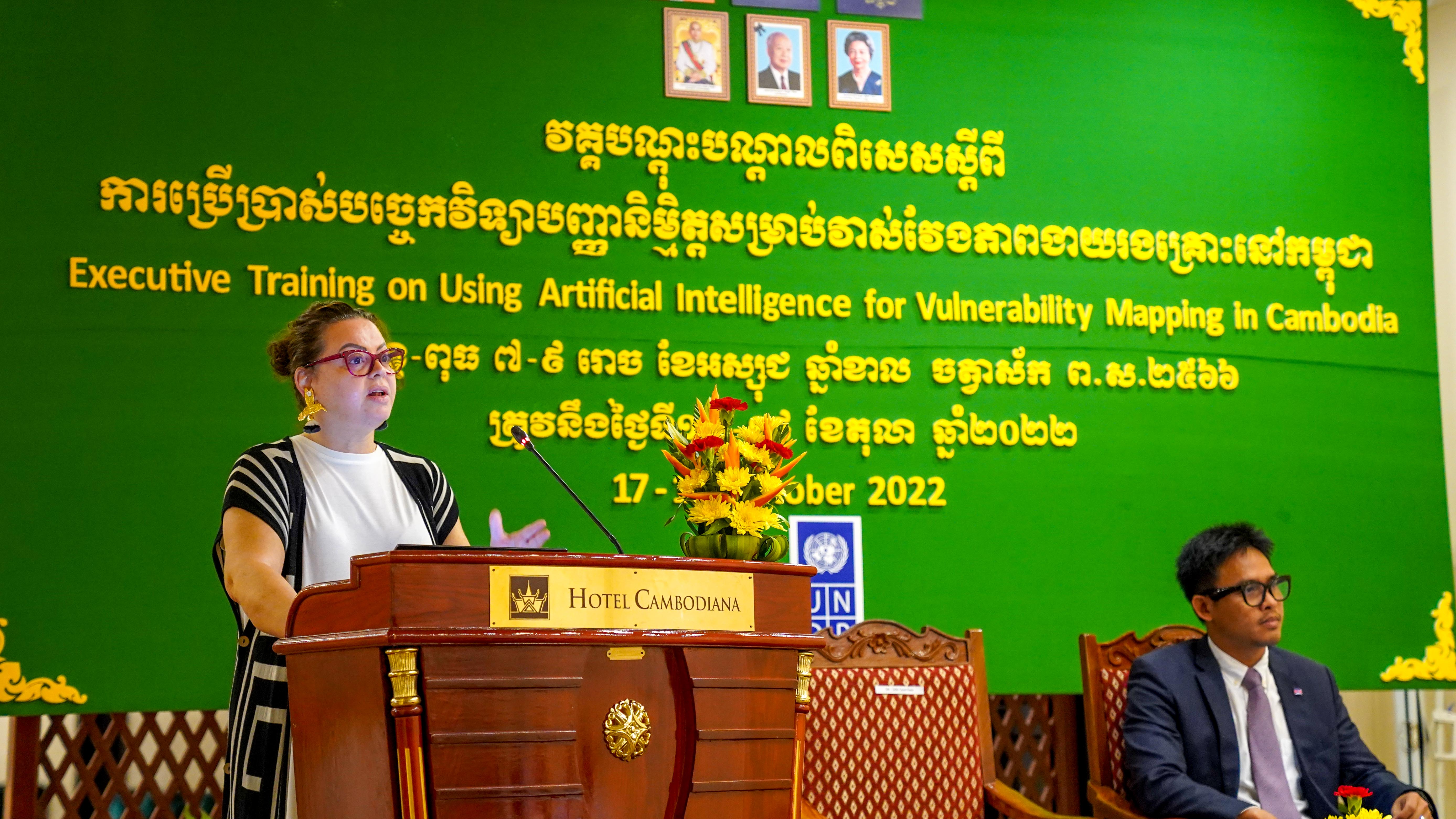Remarks by Ms. Alissar Chaker, UNDP Resident Representative
Executive Training on Using Artificial Intelligence and Big Data for Vulnerability Mapping in Cambodia
October 17, 2022

Excellency Samheng Boros, Minister attached to Prime Minister and Secretary of State of MoSVY
Excellencies, Colleagues, Ladies and Gentlemen,
Excellencies and colleagues, welcome to the three-day “Executive Training on Using Artificial Intelligence and Big Data for Vulnerability Mapping in Cambodia”.
To begin with, I would like to take this opportunity to thank my colleagues from UNDP and Spatial Informatics Group (SIG) for working very hard together over the past one year to develop an interactive online tool to map multidimensional vulnerabilities using AI and big data technology and then consult it broadly with our government counterparts before making it available for the training today.
Historically, it has been difficult to capture up-to-date, detailed information on the factors contributing to vulnerability and poverty. This is particularly true in developing nations like Cambodia. Survey data collection is usually time consuming and tedious. Fortunately, advances in machine learning and big data now allow for mapping at-risk areas within a geographic region in real-time and at an extremely low cost.
According to the most recent official poverty figure, 17.8% of Cambodia's population lives below the national poverty line. Such poverty incidence is usually correlated and thus can be explained by a wide array of vulnerability factors including lack access to quality education, clean water, improved roads, and solid waste management, just to name a few. Having data-driven ability to map these vulnerability factors in real-time is therefore instrumental to assisting an informed and efficient decision-making, directing to regions that need support the most.
Ladies and gentlemen,
Thanked to the growing arrival of inexpensive, accessible cloud computing platforms and free, publicly available datasets, the web-based Cambodian Vulnerability Mapping Tool will make vulnerability information more widely accessible in the country. This sophisticated, easy-to-use tool allows users to toggle through maps that assess multiple deficiencies in key sectors contributing to vulnerability/poverty. With this tool, users can explore multiple, overlapping vulnerabilities at the provincial, district, or commune/Sangkat levels. Users can also explore specific vulnerability indicators such as education, health, living standards, and monetary factors.
From this training, you will see that many of the Sustainable Development Goals (SDGs) have explicit spatial dimensions. Whereas the individual risk of poverty is transient, the risk of poverty can be persistent at the regional level. For example, for SDG 6 – access to clean water and sanitation, there is a clear spatial pattern with people in the main cities reporting to obtain water from the pipe and people in remote areas from tanks and wells. It is notable that households east of Phnom Penh are more likely to obtain water from the well than from a tank. There are also clear spatial patterns for access to sanitary facilities. Households in the capital and other dense urban centers are more likely to have access to a sewage system, but households in the remote areas often reported to have septic tanks, which can be seen in spatial representation. According to various studies, water from unprotected sources and lack of improved sanitation facilities are among leading causes of child morbidity in Cambodia.
As a result, the tool will benefit all users, including community leaders and government agencies. In particular, it will help answer questions about where to direct new services to have the biggest impact. These services include the location of basic infrastructure developments, the allocation of cash support, and the pilot of conditional cash transfers, and other targeting interventions to improve multi-dimensional well-being of Cambodian people, especially the poor and marginalized ones, contributing the global effort of LEAVING NO ONE BEHIND.
Ladies and gentlemen,
Advocating for open digital standards and big data is at the heart of UNDP. Our Digital Strategy 2022-2025 advocates for open digital standards to unlock scale, reusability and interoperability. The strategy seeks to increase understanding of digital technologies and how they can be used to achieve the Sustainable Development Goals, as well as the risks and trade-offs that come with them.
Working on the ground in 170 countries, UNDP supports digitalization as an enabling factor for implementing integrated solutions including by helping governments with the digitalization of payments, digital service delivery, and data-driven analytical tools. Here in Cambodia, AI for vulnerability mapping and the training today is a testament to this global commitment. We have also supported other digital solutions such as digitalization of IDPoor system, testing of distance learning and digital literacy, onboarding Small and Medium Enterprises (SME) to e-market places, and integrating innovation curriculum into the Royal School of Administration, among others.
I hope you find the training and tool useful for your work, and please feel free to share the tool with relevant colleagues. I wish you all the best throughout the training and stay safe.
Thank you!

 Locations
Locations